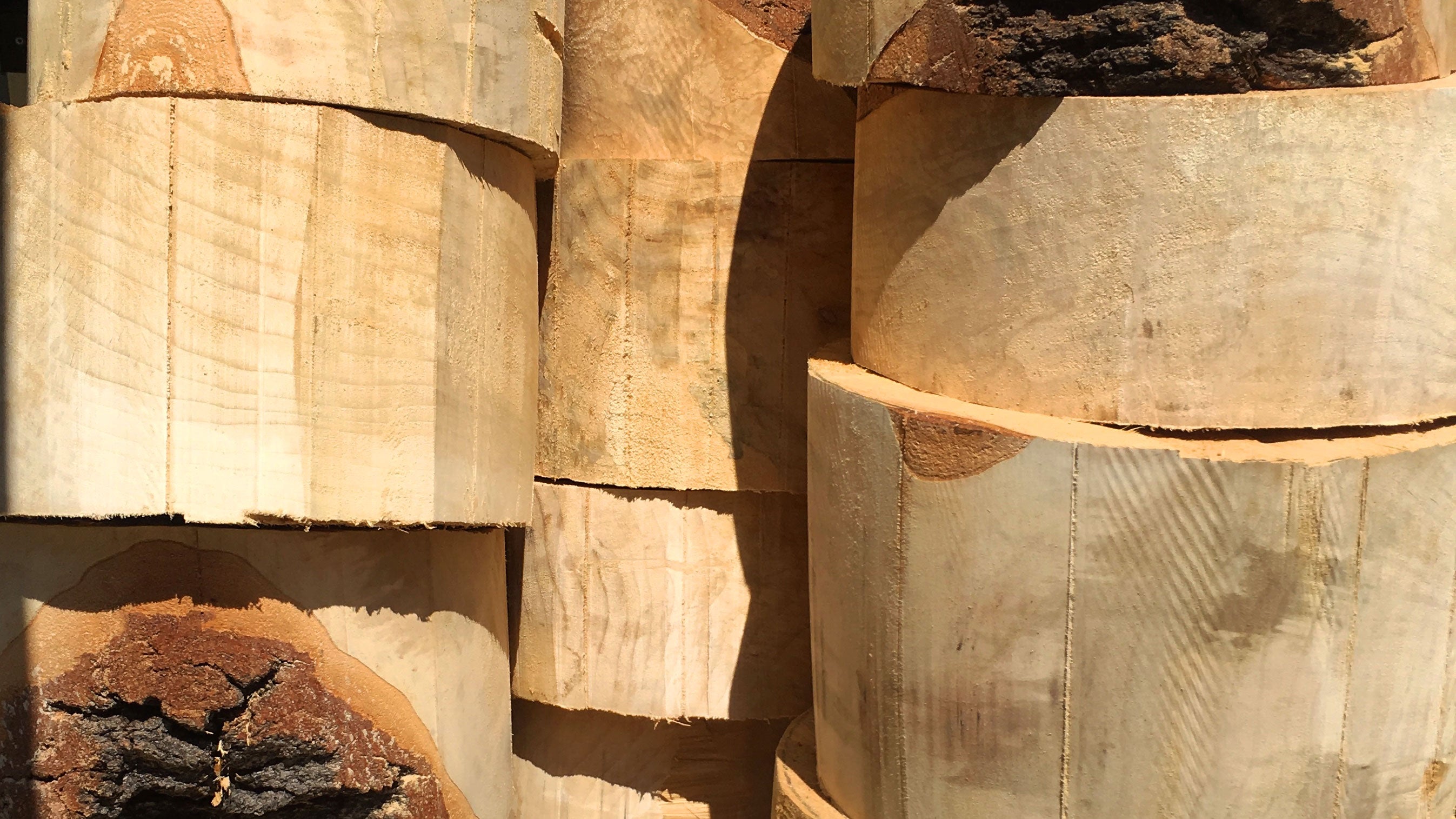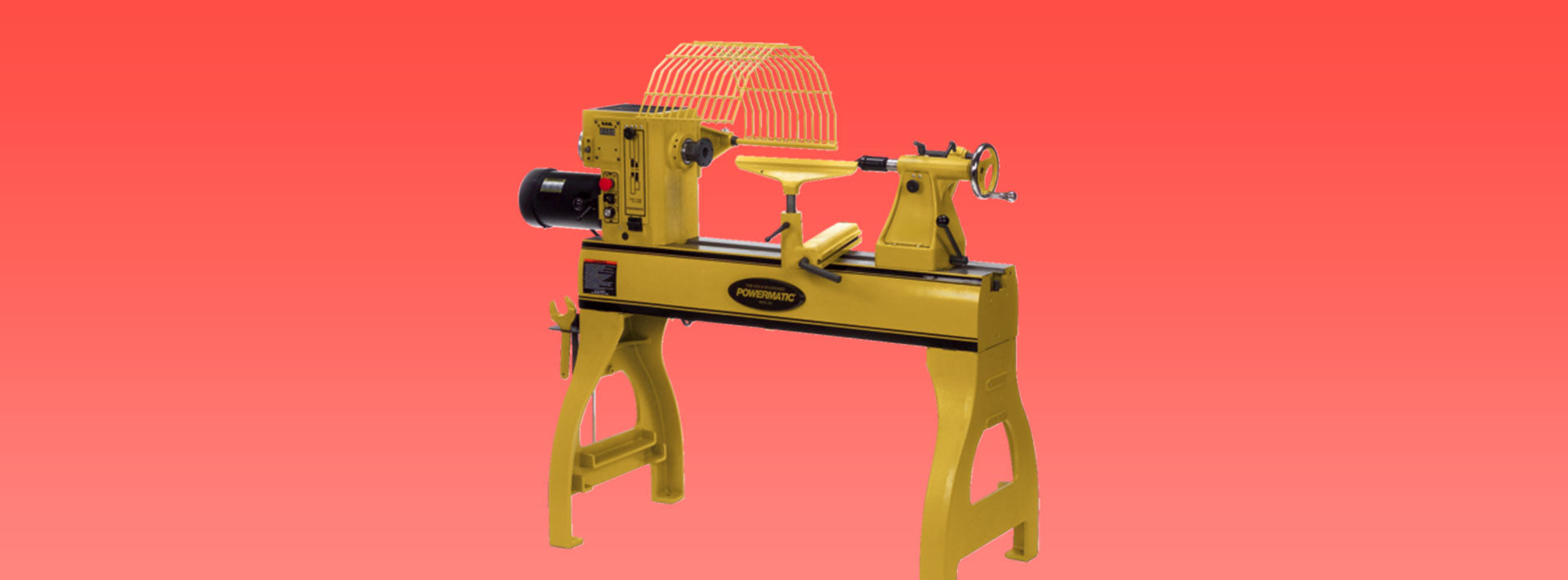Spindle Nomenclature - Shapes and Individual Features to Create Spindle Work

We have all chucked up a turning square of one kind or another and, with the set of tools common to most, roughed-out, parted-in, and gouged here, skewed there, and ended up with a potpourri of bumps and hollows that somehow pleased our senses. Lathe-hands over the centuries have been doing exactly that and, not surprisingly, have just about exhausted the number of different shapes that can be generated on a cylindrical surface.
In fact, because that number is relatively small, a system of naming evolved, and the art of turning became a matter of juxtaposing the shapes in ways that appealed to the eye while satisfying function in the final construction.
The figure on the following page includes most of the shapes you will be able to contrive, and the name ascribed to each. Your job is to pick a few of them, put them together in pleasing sizes and sequences, and come up with a work of art, or at least a leg, candlestick, or lamp. Of course the figure shows far too many individual features to be good design.
Only a few are included in most classical pieces. Assuming that the piece shown will be used in a horizontal position, let us start with
the bottom or the base and work to the top. The turners of old probably plunged in with a parting tool to mark the location of each feature first, then went back and finished between the sizing cuts.
The first section is called a plinth (1) because it is at the base and is straight-sided. Next is a torus (2), and it is a large, semi-circular shape. Above the torus is a scotia (3), from the Greek word for “shade,” so called because it is a sunk-in ovolo (compare 7). And next, perhaps the most classical of all basic forms, is the ogee (4). It is just an S shape, but it can be stretched or compressed and is usually asymmetrical in one direction or the other. Note the difference between shapes (4) and (13). With the large bulge below, it is ogee, cyma recta, and with the bulge above, it is ogee, cyma reversa.
An astragal (5) is semi-circular form that extends above the surface of the piece but is much smaller than a torus. A straight section occurring somewhere in an upper area can simply be called a neck (6). Above the neck is a protruding segment of an ellipse, an ovolo (7). Above this is a quarter-hollow (8), topped by a quarter-round (9), and then, abruptly, a ball (10), which could be elongated into an ellipse. The abrupt transition, itself called a quirk, is the only such transition on the spindle; all other shapes are separated by straight sections (called fillets), which are parallel to the axis. The flat that ends the quarter round perpendicular to the axis is just that, a flat.
Cut into the maximum diameter of the ball (or ellipse) is a semicircular bead (11). The difference between a bead and an astragal is now obvious—the bead is cut into a surface and an astragal protrudes above it. Topping the ball, a series of three fillets (12), stair-stepped in reverse, effects the transition to the ogee, cyma reversa (13). Next comes a semi-circular hollow called a cavetto (14).
You might want to call this a cove, which is a loose name for any hollow. If the hollow is semi-circular, it is a cavetto; if it is elliptical, it is a scotia.
Next is a uniform series of three beads (it could be more than three), called a reed (15). The spindle is topped by another vertical, straightsided section similar to the plinth at the bottom. However, because of its position at the top, it is called an abacus (16).
There is just about only one other turned form I can think of—a V, either negative or positive. I have
researched a goodly number of classical turned pieces, and the V is notably absent. Beyond the harsh feel and poor wearing characteristics of the positive V, I do not know why this shape has no classical favor.
So, as woodturners—beginner, intermediate, or expert—I’m quite sure these old names are new to most of you. I feel it worthwhile to resurrect this ancient lore of naming. Happy turning, now that you can name what you are doing to that billet of wood!





170 comments
شركة سكاي لخدمات نقل العفش والاثاث بالمنطقة العربية السعودية نحن نوفر خدمات نقل اثاث بالرياض ونقل عفش بالمدينة المنورة ونقل عفش بمكة ونقل عفش بالطائف نحن نقدم افضل نقل اثاث بخميس مشيط ونقل عفش بجدة
https://treeads.net/ شركة سكاي نقل العفش
https://treeads.net/blog.html مدونة لنقل العفش
https://treeads.net/movers-mecca.html شركة نقل عفش بمكة
https://treeads.net/movers-riyadh-company.html شركة نقل عفش بالرياض
https://treeads.net/all-movers-madina.html شركة نقل عفش بالمدينة المنورة
https://treeads.net/movers-jeddah-company.html شركة نقل عفش بجدة
https://treeads.net/movers-taif.html شركة نقل عفش بالطائف
https://treeads.net/movers-dammam-company.html شركة نقل عفش بالدمام
https://treeads.net/movers-qatif.html شركة نقل عفش بالقطيف
https://treeads.net/movers-jubail.html شركة نقل عفش بالجبيل
https://treeads.net/movers-khobar.html شركة نقل عفش بالخبر
https://treeads.net/movers-ahsa.html شركة نقل عفش بالاحساء
https://treeads.net/movers-kharj.html شركة نقل عفش بالخرج
https://treeads.net/movers-khamis-mushait.html شركة نقل عفش بخميس مشيط
https://treeads.net/movers-abha.html شركة نقل عفش بابها
https://treeads.net/movers-qassim.html شركة نقل عفش بالقصيم
https://treeads.net/movers-yanbu.html شركة نقل عفش بينبع
https://treeads.net/movers-najran.html شركة نقل عفش بنجران
https://treeads.net/movers-hail.html شركة نقل عفش بحائل
https://treeads.net/movers-buraydah.html شركة نقل عفش ببريدة
https://treeads.net/movers-tabuk.html شركة نقل عفش بتبوك
https://treeads.net/movers-dhahran.html شركة نقل عفش بالظهران
https://treeads.net/movers-rabigh.html شركة نقل عفش برابغ
https://treeads.net/movers-baaha.html شركة نقل عفش بالباحه
https://treeads.net/movers-asseer.html شركة نقل عفش بعسير
https://treeads.net/movers-mgmaa.html شركة نقل عفش بالمجمعة
https://treeads.net/movers-sharora.html شركة نقل عفش بشرورة
https://treeads.net/how-movers-furniture-yanbu.html كيفية نقل العفش بينبع
https://treeads.net/price-movers-furniture-yanbu.html اسعار نقل عفش بينبع
https://treeads.net/find-company-transfer-furniture-yanbu.html البحث عن شركات نقل العفش بينبع
https://treeads.net/transfer-furniture-khamis-mushit.html شركات نقل العفش بخميس مشيط
https://treeads.net/how-transfer-furniture-khamis-mushit.html كيفية نقل العفش بخميس مشيط
https://treeads.net/price-transfer-furniture-khamis-mushit.html اسعار نقل عفش بخميس مشيط
https://treeads.net/%D8%B4%D8%B1%D9%83%D8%A9-%D8%AC%D9%84%D9%8A-%D8%A8%D9%84%D8%A7%D8%B7-%D8%A8%D8%AC%D8%AF%D8%A9.html شركة جلي بلاط بجدة
https://treeads.net/%D8%B4%D8%B1%D9%83%D8%A9-%D8%AA%D9%86%D8%B8%D9%8A%D9%81-%D9%81%D9%84%D9%84-%D8%A8%D8%AC%D8%AF%D8%A9.html تنظيف فلل بجدة
https://treeads.net/company-transfer-furniture-jazan.html شركة نقل عفش بجازان
https://treeads.net/best-company-cleaning-jeddah-2020.html افضل شركة تنظيف بجدة
شركة كيان لنقل العفش بالرياض والمدينة المنورة وجدة ومكة والطائف والدمام تقديم لكم دليل كامل لشركات نقل العفش بالمملكة العربية السعودية
https://mycanadafitness.com/ شركة كيان لنقل العفش
https://mycanadafitness.com/forum.html منتدي نقل العفش
https://mycanadafitness.com/movingfurnitureriyadh.html شركة نقل اثاث بالرياض
https://mycanadafitness.com/movingfurniturejaddah.html شركة نقل اثاث بجدة
https://mycanadafitness.com/movingfurnituremecca.html شركة نقل اثاث بمكة
https://mycanadafitness.com/movingfurnituretaif.html شركة نقل اثاث بالطائف
https://mycanadafitness.com/movingfurnituremadina.html شركة نقل اثاث بالمدينة المنورة
https://mycanadafitness.com/movingfurnituredammam.html شركة نقل اثاث بالدمام
https://mycanadafitness.com/movingfurniturekhobar.html شركة نقل اثاث بالخبر
https://mycanadafitness.com/movingfurnituredhahran.html شركة نقل اثاث بالظهران
https://mycanadafitness.com/movingfurniturejubail.html شركة نقل اثاث بالجبيل
https://mycanadafitness.com/movingfurnitureqatif.html شركة نقل اثاث بالقطيف
https://mycanadafitness.com/movingfurnitureahsa.html شركة نقل اثاث بالاحساء
https://mycanadafitness.com/movingfurniturekharj.html شركة نقل اثاث بالخرج
https://mycanadafitness.com/movingfurniturekhamismushit.html شركة نقل اثاث بخميس مشيط
https://mycanadafitness.com/movingfurnitureabha.html شركة نقل اثاث بابها
https://mycanadafitness.com/movingfurniturenajran.html شركة نقل اثاث بنجران
https://mycanadafitness.com/movingfurniturejazan.html شركة نقل اثاث بجازان
https://mycanadafitness.com/movingfurnitureasir.html شركة نقل اثاث بعسير
https://mycanadafitness.com/movingfurniturehail.html شركة نقل اثاث بحائل
https://mycanadafitness.com/movingfurnitureqassim.html شركة نقل عفش بالقصيم
https://mycanadafitness.com/movingfurnitureyanbu.html شركة نقل اثاث بينبع
https://mycanadafitness.com/movingfurnitureburaidah.html شركة نقل عفش ببريدة
https://mycanadafitness.com/movingfurniturehafralbatin.html شركة نقل عفش بحفر الباطن
https://mycanadafitness.com/movingfurniturerabigh.html شركة نقل عفش برابغ
https://mycanadafitness.com/movingfurnituretabuk.html شركة نقل عفش بتبوك
https://mycanadafitness.com/movingfurnitureasfan.html شركة نقل عفش بعسفان
https://mycanadafitness.com/movingfurnituresharora.html شركة نقل عفش بشرورة
https://mycanadafitness.com/companis-moving-riyadh.html شركات نقل العفش بالرياض
https://mycanadafitness.com/cars-moving-riyadh.html سيارات نقل العفش بالرياض
https://mycanadafitness.com/company-number-moving-riyadh.html ارقام شركات نقل العفش بالرياض
https://mycanadafitness.com/company-moving-jeddah.html شركات نقل العفش بجدة
https://mycanadafitness.com/price-moving-jeddah.html اسعار نقل العفش بجدة
https://mycanadafitness.com/company-moving-mecca.html شركات نقل العفش بمكة
https://emc-mee.com/blog.html شركات نقل العفش
اهم شركات كشف تسربات المياه بالدمام كذلك معرض اهم شركة مكافحة حشرات بالدمام والخبر والجبيل والخبر والاحساء والقطيف كذكل شركة تنظيف خزانات بجدة وتنظيف بجدة ومكافحة الحشرات بالخبر وكشف تسربات المياه بالجبيل والقطيف والخبر والدمام
https://emc-mee.com/cleaning-company-yanbu.html شركة تنظيف بينبع
https://emc-mee.com/blog.html شركة نقل عفش
اهم شركات مكافحة حشرات بالخبر كذلك معرض اهم شركة مكافحة حشرات بالدمام والخبر والجبيل والخبر والاحساء والقطيف كذلك شركة رش حشرات بالدمام ومكافحة الحشرات بالخبر
https://emc-mee.com/anti-insects-company-dammam.html شركة مكافحة حشرات بالدمام
شركة تنظيف خزانات بجدة الجوهرة من افضل شركات تنظيف الخزانات بجدة حيث ان تنظيف خزانات بجدة يحتاج الى مهارة فى كيفية غسيل وتنظيف الخزانات الكبيرة والصغيرة بجدة على ايدى متخصصين فى تنظيف الخزانات بجدة
https://emc-mee.com/tanks-cleaning-company-jeddah.html شركة تنظيف خزانات بجدة
https://emc-mee.com/water-leaks-detection-isolate-company-dammam.html شركة كشف تسربات المياه بالدمام
https://emc-mee.com/ شركة الفا لنقل عفش واثاث
https://emc-mee.com/transfer-furniture-jeddah.html شركة نقل عفش بجدة
https://emc-mee.com/transfer-furniture-almadina-almonawara.html شركة نقل عفش بالمدينة المنورة
https://emc-mee.com/movers-in-riyadh-company.html شركة نقل اثاث بالرياض
https://emc-mee.com/transfer-furniture-dammam.html شركة نقل عفش بالدمام
https://emc-mee.com/transfer-furniture-taif.html شركة نقل عفش بالطائف
https://emc-mee.com/transfer-furniture-mecca.html شركة نقل عفش بمكة
https://emc-mee.com/transfer-furniture-yanbu.html شركة نقل عفش بينبع
https://emc-mee.com/transfer-furniture-alkharj.html شركة نقل عفش بالخرج
https://emc-mee.com/transfer-furniture-buraydah.html شركة نقل عفش ببريدة
https://emc-mee.com/transfer-furniture-khamis-mushait.html شركة نقل عفش بخميس مشيط
https://emc-mee.com/transfer-furniture-qassim.html شركة نقل عفش بالقصيم
https://emc-mee.com/transfer-furniture-tabuk.html شركة نقل عفش بتبوك
https://emc-mee.com/transfer-furniture-abha.html شركة نقل عفش بابها
https://emc-mee.com/transfer-furniture-najran.html شركة نقل عفش بنجران
https://emc-mee.com/transfer-furniture-hail.html شركة نقل عفش بحائل
https://emc-mee.com/transfer-furniture-dhahran.html شركة نقل عفش بالظهران
https://emc-mee.com/transfer-furniture-kuwait.html شركة نقل عفش بالكويت
https://emc-mee.com/price-transfer-furniture-in-khamis-mushit.html اسعار شركات نقل عفش بخميس مشيط
https://emc-mee.com/numbers-company-transfer-furniture-in-khamis-mushit.html ارقام شركات نقل عفش بخميس مشيط
https://emc-mee.com/new-company-transfer-furniture-in-khamis-mushit.html شركة نقل عفش بخميس مشيط جديدة
https://emc-mee.com/transfer-furniture-from-khamis-to-riyadh.html شركة نقل عفش من خميس مشيط الي الرياض
https://emc-mee.com/transfer-furniture-from-khamis-mushait-to-mecca.html شركة نقل عفش من خميس مشيط الي مكة
https://emc-mee.com/transfer-furniture-from-khamis-mushait-to-jeddah.html شركة نقل عفش من خميس مشيط الي جدة
https://emc-mee.com/transfer-furniture-from-khamis-mushait-to-medina.html شركة نقل عفش من خميس مشيط الي المدينة المنورة
https://emc-mee.com/best-10-company-transfer-furniture-khamis-mushait.html افضل 10 شركات نقل عفش بخميس مشيط
https://emc-mee.com/%D8%B4%D8%B1%D9%83%D9%87-%D9%86%D9%82%D9%84-%D8%B9%D9%81%D8%B4-%D8%A8%D8%AC%D8%AF%D9%87.html
https://emc-mee.com/%D8%B4%D8%B1%D9%83%D8%A9-%D9%86%D9%82%D9%84-%D8%A7%D8%AB%D8%A7%D8%AB-%D8%A8%D8%AC%D8%AF%D9%87.html
شركة مكافحة حشرات بالجبيل وكذلك شركة كشف تسربات المياه بالجبيل وتنظيف خزانات وتنظيف الموكيت والسجاد والكنب والشقق والمنازل بالجبيل وتنظيف الخزانات بالجبيل وتنظيف المساجد بالجبيل شركة تنظيف بالجبيل تنظيف المسابح بالجبيل
https://jumperads.com/jubail/anti-insects-company-jubail.html شركة مكافحة حشرات بالجبيل
https://jumperads.com/jubail/water-leaks-detection-company-jubail.html شركة كشف تسربات بالجبيل
https://jumperads.com/jubail/jubail-company-surfaces.html شركة عزل اسطح بالجبيل
https://jumperads.com/jubail/jubail-company-sewage.html شركة تسليك مجاري بالجبيل
https://jumperads.com/jubail/jubail-cleaning-company-sofa.html شركة تنظيف كنب بالجبيل
https://jumperads.com/jubail/jubail-cleaning-company-mosques.html شركة تنظيف مساجد بالجبيل
https://jumperads.com/jubail/jubail-cleaning-company-Carpet.html شركة تنظيف سجاد بالجبيل
https://jumperads.com/jubail/jubail-cleaning-company-tanks.html شركة تنظيف خزانات بالجبيل
https://jumperads.com/jubail/jubail-cleaning-company-swimming-bath.html شركة تنظيف وصيانة مسابح بالجبيل
https://jumperads.com/jubail/jubail-cleaning-company-Furniture.html شركة تنظيف الاثاث بالجبيل
https://jumperads.com/jubail/jubail-cleaning-company-home.html شركة تنظيف شقق بالجبيل
https://jumperads.com/jubail/jubail-cleaning-company-Carpets.html شركة تنظيف موكيت بالجبيل
https://jumperads.com/jubail/jubail-cleaning-company.html شركة تنظيف مجالس بالجبيل
https://jumperads.com/jubail/jubail-cleaning-company-house.html شركة تنظيف منازل بالجبيل
https://jumperads.com/jubail/jubail-cleaning-company-curtains.html شركة تنظيف ستائر بالجبيل
https://jumperads.com/jubail/jubail-cleaning-company-Villas.html شركة تنظيف فلل بالجبيل
https://jumperads.com/jubail/jubail-company-tile.html شركة جلي بلاط بالجبيل
https://spo1top.com/
https://bit.ly/3EhPU7n
https://cutt.ly/BwkKBIGJ
아시안커넥트 에이전시 https://spo1top.com/asianconnect/
에볼루션카지노 https://spo1top.com/evolution/
스보벳 https://spo1top.com/sbobet/
핀벳88(피나클) https://spo1top.com/pinbet88/
맥스벳 https://spo1top.com/maxbet/
비티아이 스포츠 https://spo1top.com/bti-sports/
플레이테크 https://spo1top.com/playtech/
아시안커넥트 우회주소 https://bit.ly/3ZLZOrF 추천인 TM66
실시간스포츠중계 https://bit.ly/3ZLZOrF 추천인 TM66
해외스포츠배팅사이트 https://spo1top.com/
해외배팅사이트추천 https://spo1top.com/
해외배팅사이트에이전시 https://spo1top.com/
안전온라인카지노 https://spo1top.com/
안전해외배팅사이트 https://spo1top.com/
안전배팅사이트 https://spo1top.com/
아시안커넥트 IGX골프 배팅 https://spo1top.com/asianconnect/
아시안커넥트 가입 https://spo1top.com/asianconnect/
아시안커넥트 추천 https://spo1top.com/asianconnect/
아시안커넥트 도메인 https://spo1top.com/asianconnect/
아시안커넥트 안전주소 https://spo1top.com/asianconnect/
https://www.canva.com/design/DAFxNkoJmjE/7reHHLxcnnLE52j9Hi62pw/view?utm_content=DAFxNkoJmjE&utm_campaign=designshare&utm_medium=link&utm_source=editor
https://linktr.ee/spo1top
https://spo1top.taplink.ws
https://sleek.bio/spo1top
https://spo1top.carrd.co/
https://linkbio.co/5102210L2HxPG
https://solo.to/spo1top
https://linkfly.to/spo1top
https://sites.google.com/view/asianconnect/
https://sites.google.com/view/btisports/
https://sites.google.com/view/maxbet7/
https://sites.google.com/view/asianconect/
https://sites.google.com/view/sbobet10/
https://sites.google.com/view/pinbet88/
https://www.sites.google.com/view/asianconect/%2F
https://sites.google.com/view/asianconect/%EC%95%84%EC%8B%9C%EC%95%88%EC%BB%A4%EB%84%A5%ED%8A%B8
https://docs.google.com/drawings/d/1Rw9uy_zVHH-HFMfC6zzDogmKWEX4QfRJKouLbBVDX9Q/
https://docs.google.com/drawings/d/1jfDjmepvqsFmjddMk9ExSpiucLuLCooG25nHYJJv32E/
https://docs.google.com/drawings/d/1aOosLvI9NmB14qzndI73GAlLEbqLMx9ch9DKc66TIRE/
https://docs.google.com/drawings/d/1iw_h50dwb711A3vZJdapzQeqNjP8qSSAzOLTq1txjX4/
https://docs.google.com/drawings/d/1UlCrDTUNaz-oNqO7oehLZVMbQML_uu3mTVwxeOAUAno/
https://tinylink.net/4ZS0x+
https://cb.click/gezr+
https://rb.gy/ip20y
https://shortnr.net/fhaJs
https://tinyurl.com/3hpx2map
https://bitly.ws/TJ2F
https://rroll.to/4Pmfpd
https://biturl.top/MRjAz2
https://tinylink.net/4ZS0x
https://duckduckgo.com/?q=https%3A%2F%2Fspo1top.com&t=h_&ia=web
https://www.google.com/search?q=spo1top.com&sca_esv=569194044&hl=ko&sxsrf=AM9HkKmJjhBliQSG9n_h8yImPajTLCWG0w%3A1695919990463&source=hp&ei=dq8VZa6FGtSmoAT9sLSYAw&iflsig=AO6bgOgAAAAAZRW9hvM4W-0_kj2qMiSEzo-G4vnLX9TF&oq=&gs_lp=Egdnd3Mtd2l6IgAqAggIMgcQIxjqAhgnMgcQIxjqAhgnMgcQIxjqAhgnMgcQIxjqAhgnMgcQIxjqAhgnMgcQIxjqAhgnMgcQIxjqAhgnMgcQIxjqAhgnMgcQIxjqAhgnMgcQIxjqAhgnSLxAUABYAHABeACQAQCYAQCgAQCqAQC4AQHIAQCoAgo&sclient=gws-wiz#ip=1
https://spo1top.wordpress.com/2023/10/03/australias-aml-controller-uncovers-severe-new-client-check-necessities-for-internet-gaming-administrators/
https://spo9top.wordpress.com/2023/10/03/online-gambling-clubs-can-offer-a-wide-range-of-reward-schemes/
https://spo3top.wordpress.com/2023/10/03/kambi-pens-multichannel-sportsbookdeal-with-svenska-spel/
https://spo1top3.wordpress.com/2023/10/03/sports-wagering-handle-and-income-take-a-jump-in-ohio-during-august/
https://spo1topblog.wordpress.com/2023/10/03/online-crypto-gambling-club-bets-io-adds-sports-wagering-by-means-of-softswiss-sportsbook-organization/
https://spo1top4.wordpress.com/2023/10/03/how-do-undergrads-sports-bet-regardless-of-legitimate-limits/
https://spo1top1.wordpress.com/2023/10/03/genuine-sociedad-is-live-underdog-in-champions-league-match-with-rb-salzburg/
https://spo20top.blogspot.com/2023/10/best-thursday-night-football-sports.html
https://spo20top.mystrikingly.com/blog/nevada-rep-commends-nfl-for-patched-up-sports-wagering-strategy-however
https://spo10top.blogspot.com/2023/10/underage-betting-in-australia-ought-to.html
https://spo10top.mystrikingly.com/blog/best-school-football-wagering-promotions-2023-ncaaf-bet-rewards
https://spo3top.blogspot.com/2023/10/parimatch-your-passage-to-unmatched.html
https://spo3top.mystrikingly.com/blog/5-mlb-wagering-promotions-to-get-thursday-incorporating-up-to-1000-in-rewards
https://spo5top.blogspot.com/2023/10/wagering-on-namibian-football-matches.html
https://spo5top.mystrikingly.com/blog/best-ohio-sports-wagering-promotions-for-nfl-tnf-bears-leaders
https://spo7top.blogspot.com/2023/10/on-request-chances-how-streaming-stages.html
https://spo7top.mystrikingly.com/blog/from-beginner-to-ace-building-a-beneficial-games-wagering-procedure-in-nigeria
https://spo20top.blogspot.com/2023/10/online-crypto-gambling-club-wagers-adds.html
https://spo20top.mystrikingly.com/blog/managerial-changes-in-uk-sports-betting-what-you-truly-need-to-know
https://spo10top.blogspot.com/2023/10/update-no-gambling-clubs-inc-needs-say.html
https://spo10top.mystrikingly.com/blog/gaming-and-customary-games-wagering-business-sector-2023-fragment-type
https://spo5top.blogspot.com/2023/10/around-sports-to-presentation-sports.html
https://spo5top.mystrikingly.com/blog/sports-wagering-spikes-in-the-us-help-for-issue-card-sharks-extends
https://spo3top.blogspot.com/2023/10/excelling-at-sports-wagering-procedures.html
https://spo3top.mystrikingly.com/blog/new-york-sports-wagering-income-arrives-at-record-high-as-nfl-season-starts
https://spo7top.blogspot.com/2023/10/draftkings-michigan-promotion-code.html
https://spo20top.blogspot.com/2023/10/when-is-online-games-wagering.html
https://spo20top.mystrikingly.com/blog/what-s-the-significance-here-in-sports-wagering
https://spo1top1.wordpress.com/2023/10/09/want-to-wager-schools-taking-watchfulness-with-sports-betting/
https://spo10top.blogspot.com/2023/10/how-man-made-intelligence-and-ar-could.html
https://spo10top.mystrikingly.com/blog/the-rising-notoriety-of-online-games-wagering-a-computerized-development
https://spo1top4.wordpress.com/2023/10/09/sports-wagering-carries-gobs-of-cash-to-kentucky/
https://spo5top.blogspot.com/2023/10/maine-sports-wagering.html
https://spo5top.mystrikingly.com/blog/investigating-the-advantages-of-digital-currency-wagering-on-the-web
https://spo1top3.wordpress.com/2023/10/09/how-does-sports-wagering-work/
https://spo3top.blogspot.com/2023/10/sports-wagering-applications-how-to-be.html
https://spo3top.mystrikingly.com/blog/online-games-wagering-could-start-statewide-in-florida-when-monday
https://spo3top.wordpress.com/2023/10/10/could-online-games-wagering-return-to-florida-a-lawyer-makes-sense-of-the-chance/
https://spo7top.blogspot.com/2023/10/texas-online-games-wagering-is-it.html
https://spo7top.mystrikingly.com/blog/is-sports-wagering-continuing-in-florida-seminole-clan-faces-choice-in-the
https://spo1topblog.wordpress.com/2023/10/09/sports-wagering-in-california-when-it-will-be-legitimate-how-to-wager-on-the-web-where-to-get-picks-most-recent-promotions/
https://spo20top.blogspot.com/2023/10/kentucky-sees-flood-in-numbers-with.html
https://spo20top.mystrikingly.com/blog/adolescents-are-creating-serious-betting-issues-as-internet-wagering-floods
https://spo1top1.wordpress.com/2023/10/11/wagering-on-progress-exploring-the-present-scene-of-beginning-a-games-wagering-business/
https://spo10top.blogspot.com/2023/10/ontarios-in-general-q2-betting-figures.html
https://spo10top.mystrikingly.com/blog/how-has-sports-wagering-influenced-ny
https://spo1top4.wordpress.com/2023/10/11/sports-wagering-administrator-northstar-gaming-intends-to-send-off-betting-across-canada/
https://spo5top.blogspot.com/2023/10/promotion-dollars-stream-in-first.html
https://spo5top.mystrikingly.com/blog/best-school-ball-wagering-destinations-and-applications-2023
https://spo1top3.wordpress.com/2023/10/11/brazils-games-wagering-bill-picks-up-speed-with-new-rapporteur/
https://spo3top.blogspot.com/2023/10/sports-wagering-in-wexford-your.html
https://spo3top.mystrikingly.com/blog/states-should-settle-pick-them-sports-betting-conversation-draftkings-and
https://spo3top.wordpress.com/2023/10/12/colorado-sports-wagering-income-up-to-25-8m-in-august-mirrors-2022-aggregate/
https://spo7top.blogspot.com/2023/10/day-to-day-dream-sports-administrators.html
https://spo7top.mystrikingly.com/blog/amplifying-client-securing-powerful-promoting-techniques-for-sportsbooks-in
https://spo1topblog.wordpress.com/2023/10/11/discuss-mississippi-move-to-sanction-portable-games-wagering-given-lift-following-remarks-from-state-congressperson/
https://spo20top.blogspot.com/2023/10/us-high-court-puts-hang-on-florida.html
https://spo20top.mystrikingly.com/blog/miscellaneous-items-the-changing-scene-of-contemporary-betting-and-sports
https://spo1top1.wordpress.com/2023/10/12/elys-dispatches-new-sportbet-brand-in-us/
https://spo10top.blogspot.com/2023/10/boss-equity-john-roberts-stops-clans.html
https://spo10top.mystrikingly.com/blog/sports-wagering-sites-bet-on-banksy-s-genuine-personality
https://spo1top4.wordpress.com/2023/10/12/ascent-of-portable-games-wagering-in-new-york-prompts-expanded-state-income-more-issue-betting-related-calls-specialist-finds/
https://spo5top.blogspot.com/2023/10/how-man-made-knowledge-and-ar-could.html
https://spo5top.mystrikingly.com/blog/versatile-games-wagering-procures-nys-more-than-700-million-in-income
https://spo1top3.wordpress.com/2023/10/12/no-betting-clubs-goals-expect-sweeping-games-betting/
https://spo3top.blogspot.com/2023/10/portable-games-wagering-great-for.html
https://spo3top.mystrikingly.com/blog/sports-betting-basic-and-well-known-in-ohio-yet-it-can-come-at-a-ssuper-cost
https://spo3top.wordpress.com/2023/10/13/colorado-sees-less-games-wagering-on-baseball-this-late-spring/
https://spo7top.blogspot.com/2023/10/business-by-books-caesars-spending.html
https://spo7top.mystrikingly.com/blog/shared-sports-wagering-is-crypto-s-next-executioner-application
https://spo1topblog.wordpress.com/2023/10/12/nfl-embraces-legitimized-sports-wagering/
https://spo20top.blogspot.com/2023/10/us-sports-wagering-heres-where-every.html
https://spo20top.mystrikingly.com/blog/north-carolina-sports-wagering-send-off-and-lawful-updates-2023
https://spo1top1.wordpress.com/2023/10/15/effects-of-online-games-wagering-on-su-understudies/
https://spo10top.blogspot.com/2023/10/high-court-requested-of-to-stop-florida.html
https://spo10top.mystrikingly.com/blog/top-games-wagering-welcome-rewards-for-thursday-night-football-smartest-choices
https://spo1top4.wordpress.com/2023/10/15/north-carolina-sports-wagering-new-spending-plan-permits-limitless-portable-sportsbooks/
https://spo5top.blogspot.com/2023/10/the-rising-notoriety-of-internet-games.html
https://spo5top.mystrikingly.com/blog/florida-online-games-wagering-on-hold
https://spo1top3.wordpress.com/2023/10/15/how-man-made-intelligence-and-ar-could-build-the-gamble-of-issue-betting-for-online-games-wagering/
https://spo3top.blogspot.com/2023/10/when-is-online-games-wagering.html
https://spo3top.mystrikingly.com/blog/u-s-high-court-puts-hang-on-florida-sports-wagering-plan
https://spo3top.wordpress.com/2023/10/16/kansas-crushes-sports-wagering-handle-record-in-september/
https://spo7top.blogspot.com/2023/10/sports-betting-conveys-boatloads-of.html
https://spo7top.mystrikingly.com/blog/betting-on-progress-investigating-the-current-scene-of-starting-a-games
https://spo1topblog.wordpress.com/2023/10/15/what-will-the-ascent-of-online-games-wagering-mean-for-sports-participation-in-illinois/
https://spo20top.blogspot.com/2023/10/the-unrest-of-billard-wagering-profound.html
https://spo20top.mystrikingly.com/blog/australian-betting-faceoff-sports-wagering-versus-online-club
https://spo1top1.wordpress.com/2023/10/16/monday-night-football-wagering-promotions-score-top-rewards-on-ranchers-versus-chargers/
https://spo10top.blogspot.com/2023/10/greatness-and-excitement-which-avid.html
https://spo10top.mystrikingly.com/blog/best-pittsburgh-steelers-wagering-promotion-codes-and-rewards-top-steelers
https://spo1top4.wordpress.com/2023/10/16/english-horseracing-faces-mass-migration-of-bettors-assuming-that-nosy-moderateness-checks-are-presented-by-betting-commission-review-finds/
https://spo5top.blogspot.com/2023/10/kicking-it-up-score-rushes-and-dangers.html
https://spo5top.mystrikingly.com/blog/does-football-have-a-betting-issue
https://spo1top3.wordpress.com/2023/10/16/wagering-on-the-2023-recipe-1-race-at-circuit-of-the-americas-what-you-want-to-be-aware/
https://spo3top.blogspot.com/2023/10/peru-endorses-betting-guidelines.html
https://spo3top.mystrikingly.com/blog/riding-the-computerized-wave-how-sports-wagering-upset-internet-betting
https://spo3top.wordpress.com/2023/10/17/sports-funding-meps-maintain-that-should-expand-tolls-on-duties-on-sports-wagering/
https://spo7top.blogspot.com/2023/10/maryland-sports-wagering-bounce-back.html
https://spo7top.mystrikingly.com/blog/la-liga-the-home-of-a-portion-of-the-world-s-greatest-clubs
https://spo1topblog.wordpress.com/2023/10/16/make-your-own-bet-a-manual-for-bet-manufacturers/
https://spo20top.blogspot.com/2023/10/bunch-calls-floridas-games-wagering.html
https://spo20top.mystrikingly.com/blog/no-club-submits-amicus-brief-in-florida-sports-betting-case
https://spo1top1.wordpress.com/2023/10/17/assessed-4b-to-be-spent-on-maryland-portable-games-wagering-in-first-year/
https://spo10top.blogspot.com/2023/10/north-carolina-sports-wagering-rules.html
https://spo10top.mystrikingly.com/blog/network-safety-mindfulness-month-features-chance-of-online-games-wagering
https://spo1top4.wordpress.com/2023/10/17/sports-web-wagers-close-record-levels-in-nj-however-5-of-9-ac-gambling-clubs-trail-pre-pandemic-levels/
https://spo5top.blogspot.com/2023/10/massachusetts-draftkings-takes-record.html
https://spo5top.mystrikingly.com/blog/monitoring-asx-sports-wagering-stocks-as-additional-us-states-support-betting
https://spo1top3.wordpress.com/2023/10/17/finding-the-ideal-games-book-6-highlights-you-shouldnt-disregard/
https://spo3top.blogspot.com/2023/10/what-will-lower-kentucky-games-wagering.html
https://spo3top.mystrikingly.com/blog/the-situation-with-sports-wagering-in-california-a-gander-at-the-present-and
https://spo3top.wordpress.com/2023/10/18/gig-presents-sports-wagering-audits-rewards-site-apuestas-argentinas-to-the-argentine-market/
https://spo7top.blogspot.com/2023/10/from-space-games-to-sports-wagering.html
https://spo7top.mystrikingly.com/blog/tipico-makes-a-big-appearance-new-first-class-exclusive-gambling-club
https://spo1topblog.wordpress.com/2023/10/17/continue-to-roll-the-most-recent-advancements-in-club-unwaveringness-projects/
https://spo20top.blogspot.com/2023/10/superbook-sports-dispatches-online.html
https://spo20top.mystrikingly.com/blog/kentucky-games-wagering-applications-sportsbooks-and-offers
https://spo1top1.wordpress.com/2023/10/20/peru-supports-duty-regulation-for-online-games-wagering-and-igaming-administrators/
https://spo10top.blogspot.com/2023/10/web-based-betting-and-sports-wagering.html
https://spo10top.mystrikingly.com/blog/australian-betting-faceoff-sports-wagering-versus-online-gambling-clubs
https://spo1top4.wordpress.com/2023/10/20/why-portable-games-wagering-is-turning-out-to-be-more-well-known/
https://spo5top.blogspot.com/2023/10/north-carolina-sports-wagering-primer.html
https://spo5top.mystrikingly.com/blog/what-sorts-of-wagers-might-you-at-any-point-make-on-carolina-jaguars-chances
https://spo1top3.wordpress.com/2023/10/20/expect-sports-wagering-ma-piece-of-the-pie-adjustments-in-2024/
https://spo3top.blogspot.com/2023/10/spearheading-future-of-wagering.html
https://spo3top.mystrikingly.com/blog/north-carolina-sports-wagering-fundamental-principles-laid-out-for-versatile
https://spo7top.blogspot.com/2023/10/should-online-games-wagering-firms-keep.html
https://spo7top.mystrikingly.com/blog/why-online-games-wagering-is-more-famous-than-in-person-wagering
https://spo1topblog.wordpress.com/2023/10/20/online-games-wagering-begins-with-a-bang/
https://spo20top.blogspot.com/2023/10/a-general-aide-about-sports-wagering.html
https://spo20top.mystrikingly.com/blog/draftkings-takes-piece-of-the-pie-lead-in-u-s-internet-betting
https://spo1top1.wordpress.com/2023/10/22/superbook-sports-dispatches-online-games-wagering-in-virginia-its-10th-state-live-in-the-us/
https://spo10top.blogspot.com/2023/10/kentucky-opens-real-web-based-sports.html
https://spo10top.mystrikingly.com/blog/what-sorts-of-wagers-could-you-at-any-point-make-on-carolina-typhoons-chances
https://spo1top4.wordpress.com/2023/10/22/electronic-wagering-and-sports-betting-at-a-record-level-in-new-jersey-in-september-pre-pandemic-level-not-came-to-yet/
https://spo5top.blogspot.com/2023/10/best-school-football-wagering-sports.html
https://spo5top.mystrikingly.com/blog/connecticut-online-gambling-club-sports-wagering-handles-take-off-in-september
https://spo1top3.wordpress.com/2023/10/22/what-kinds-of-bets-might-you-anytime-at-any-point-make-on-carolina-pumas-chances-on-the-web/
https://spo3top.blogspot.com/2023/10/network-insurance-care-month-highlights.html
https://spo3top.mystrikingly.com/blog/leading-the-future-of-betting-creative-jump-advances-in-online-sportsbooks
https://spo7top.blogspot.com/2023/10/why-internet-games-betting-is-more.html
https://spo7top.mystrikingly.com/blog/sports-web-wagers-close-record-levels-in-new-jersey-however-5-of-9-gambling
https://spo1topblog.wordpress.com/2023/10/22/innovation-reforms-the-universe-of-online-games-wagering/
https://spo20top.blogspot.com/2023/10/determinants-of-issue-sports-wagering.html
https://spo20top.mystrikingly.com/blog/an-overall-helper-about-sports-betting
https://spo1top1.wordpress.com/2023/10/23/federal-authorities-say-betting-decision-ought-to-push-ahead/
https://spo10top.blogspot.com/2023/10/the-fate-of-betting-investigating.html
https://spo10top.mystrikingly.com/blog/dad-sports-wagering-promotions-spike-to-record-levels-as-nfl-returns
https://spo1top4.wordpress.com/2023/10/23/from-punters-to-hot-shots-how-sports-wagering-changes-the-uk-club-scene/
https://spo5top.blogspot.com/2023/10/senate-rapporteur-assesses-different.html
https://spo5top.mystrikingly.com/blog/paynearme-and-ncr-atleos-accomplice-to-extend-igaming-money-withdrawals
https://spo1top3.wordpress.com/2023/10/23/betting-brand-play-alberta-revives-the-fun-in-the-ordinary/
https://spo3top.blogspot.com/2023/10/why-might-it-be-smart-for-you-to.html
https://spo3top.mystrikingly.com/blog/norway-announces-dns-hindering-game-plan
https://spo7top.blogspot.com/2023/10/draftkings-issues-discounts-to-bijan.html
https://spo7top.mystrikingly.com/blog/georgia-gaming-interests-to-re-energize-legitimization-push-for-sports
https://spo1topblog.wordpress.com/2023/10/23/draftkings-plays-the-right-cards-in-web-based-gaming-development/
https://spo20top.blogspot.com/2023/10/mississippi-officials-preparing-for.html
https://spo20top.mystrikingly.com/blog/here-s-the-reason-you-ought-to-bet-in-an-authorized-web-based-sportsbook
https://spo1top1.wordpress.com/2023/10/24/online-games-wagering-records-for-93-of-kentuckys-248-million-handle-since-send-off/
https://spo10top.blogspot.com/2023/10/gan-to-bring-sports-wagering-stage-to.html
https://spo10top.mystrikingly.com/blog/warhorse-gambling-club-to-open-new-retail-sportsbook-in-nebraska
https://spo1top4.wordpress.com/2023/10/24/draftkings-take-driving-situation-in-the-us-web-based-betting-business-region/
https://spo5top.blogspot.com/2023/10/biden-organization-says-florida-betting.html
https://spo5top.mystrikingly.com/blog/subject-matter-expert-more-thought-expected-for-implications-of-ny
https://spo1top3.wordpress.com/2023/10/24/genuine-betis-expands-association-with-olybet-in-europe/
https://spo3top.blogspot.com/2023/10/investigating-new-skylines-in-kenyan.html
https://spo3top.mystrikingly.com/blog/superbook-sports-ventures-into-10th-us-state
https://spo7top.blogspot.com/2023/10/french-gaming-administrator-fdj-brings.html
https://spo7top.mystrikingly.com/blog/fellow-reports-an-expansion-in-income-from-destructive-betting-for-q3-2023
https://spo1topblog.wordpress.com/2023/10/24/churchill-downs-consolidated-the-eventual-fate-of-sports-wagering/
https://spo20top.blogspot.com/2023/10/high-court-permits-portable-games.html
https://spo20top.mystrikingly.com/blog/arizona-sports-wagering-spend-outperforms-358m-in-august
https://spo1top1.wordpress.com/2023/10/25/nustar-club-resort-dispatches-sports-wagering-stage/
https://spo10top.blogspot.com/2023/10/will-man-made-awareness-make-sports.html
https://spo10top.mystrikingly.com/blog/michigan-online-club-hop-counterbalances-sports-wagering-dunk-in-september
https://spo1top4.wordpress.com/2023/10/25/the-appalling-revolting-side-of-sports-betting/
https://spo5top.blogspot.com/2023/10/sports-wagering-destinations-what-you.html
https://spo5top.mystrikingly.com/blog/mississippi-online-games-wagering-guidelines-keep-on-coming-to-fruition
https://spo1top3.wordpress.com/2023/10/25/nebraska-board-oks-sports-betting-at-warhorse-club-omaha-however-no-wagers-until-november/
https://spo3top.blogspot.com/2023/10/betting-stage-taps-seem-to-convey-live.html
https://spo3top.mystrikingly.com/blog/who-gathered-illinois-sports-wagering-speed-in-august
https://spo7top.blogspot.com/2023/10/engaging-chances-ladies-games-wagering.html
https://spo7top.mystrikingly.com/blog/computer-based-iintelligence-in-the-worldwide-championship-a-huge-homerun-or
https://spo1topblog.wordpress.com/2023/10/25/bet-at-home-cuts-whole-year-pay-course/
https://spo20top.blogspot.com/2023/10/sports-wagering-in-georgia-when-it-will.html
https://spo20top.mystrikingly.com/blog/betway-drops-bid-in-illinois-for-online-just-games-wagering-permit
https://spo1top1.wordpress.com/2023/10/26/advantages-of-sports-wagering-on-the-web/
https://spo10top.blogspot.com/2023/10/digital-currency-use-fills-in-worldwide.html
https://spo10top.mystrikingly.com/blog/italian-soccer-player-adds-to-sports-wagering-related-infringement
https://spo1top4.wordpress.com/2023/10/26/billiards-wagering-examining-the-chances-and-anticipating-results/
https://spo5top.blogspot.com/2023/10/dream-pickem-suppliers-put-on-guarded.html
https://spo5top.mystrikingly.com/blog/new-york-treatment-facilities-work-to-help-those-engaging-betting-enslavement
https://spo1top3.wordpress.com/2023/10/26/parimatch-your-definitive-manual-for-wagering-in-india/
https://spo3top.blogspot.com/2023/10/asians-put-down-higher-web-based-wagers.html
https://spo3top.mystrikingly.com/blog/high-court-permits-versatile-games-wagering-at-seminole-clan-gambling-clubs
https://spo7top.blogspot.com/2023/10/bitsler-survey-uncovering-universe-of.html
https://spo7top.mystrikingly.com/blog/estimating-the-web-based-gaming-and-betting-gamble-for-mn-youth
https://spo1topblog.wordpress.com/2023/10/26/past-today-the-eventual-fate-of-igaming-in-new-jersey/
https://spo20top.blogspot.com/2023/10/sports-wagering-in-north-carolina-when.html
https://spo20top.mystrikingly.com/blog/sandy-s-dashing-and-gaming-brings-legitimate-games-wagering-to-boyd-province
https://spo1top1.wordpress.com/2023/10/27/how-payouts-are-determined-on-sports-wagering-destinations/
https://spo10top.blogspot.com/2023/10/sports-wagering-techniques-how-to-make.html
https://spo10top.mystrikingly.com/blog/betway-drops-bid-in-illinois-for-online-simply-games-betting-grant
https://spo1top4.wordpress.com/2023/10/27/brazils-money-clergyman-tries-to-forestall-sports-wagering-on-state-lotteries/
https://spo5top.blogspot.com/2023/10/twenty-to-thirty-year-olds-make-up.html
https://spo5top.mystrikingly.com/blog/has-kentucky-s-send-off-influenced-west-virginia-sports-wagering
https://spo1top3.wordpress.com/2023/10/27/the-connection-among-digital-money-and-sports/
https://spo3top.blogspot.com/2023/10/advanced-cash-use-fills-in-overall.html
https://spo3top.mystrikingly.com/blog/from-cash-bonanzas-to-pizza-texas-officers-fans-are-wagering-enthusiastic
https://spo7top.blogspot.com/2023/10/reproachful-of-thinking-about-direct.html
https://spo7top.mystrikingly.com/blog/iowa-football-understudy-partner-owen-o-brien-concedes-to-underage-betting
https://spo1topblog.wordpress.com/2023/10/27/obscure-bits-of-trivia-about-the-idea-of-sports-wagering-in-the-us/
https://spo20top.blogspot.com/2023/10/us-high-court-gives-lift-to-sports.html
https://spo20top.mystrikingly.com/blog/california-sports-wagering-2-0-secret-voting-form-drive-proposition-documented
https://spo1top1.wordpress.com/2023/10/29/extension-of-portable-games-gaming-beyond-club-considered/
https://spo10top.blogspot.com/2023/10/betmgm-philadelphia-76ers-organization.html
https://spo10top.mystrikingly.com/blog/nevada-loosens-up-esports-wagering-guidelines-for-nearby-sportsbooks
https://spo1top4.wordpress.com/2023/10/29/top-10-realities-aussies-need-to-be-familiar-with-betting/
https://spo5top.blogspot.com/2023/10/medicines-for-betting-fixation-and.html
https://spo5top.mystrikingly.com/blog/sports-betting-in-florida-has-it-been-approved-update-how-to-bet-on-the
https://spo1top3.wordpress.com/2023/10/29/sports-wagering-firms-proposition-to-slip-out-of-the-pullover-game/
https://spo3top.blogspot.com/2023/10/bbb-alert-con-artists-bet-fans-will.html
https://spo3top.mystrikingly.com/blog/government-specialists-say-florida-sports-betting-overseeing-should-push-ahead
https://spo7top.blogspot.com/2023/10/us-high-court-rejects-challenge-to.html
https://spo7top.mystrikingly.com/blog/one-more-hindrance-to-online-games-wagering-falls-however-different
https://spo1topblog.wordpress.com/2023/10/29/whats-the-significance-here-in-sports-wagering-juice-wagering-made-sense-of/